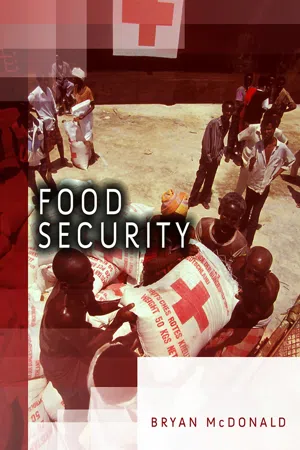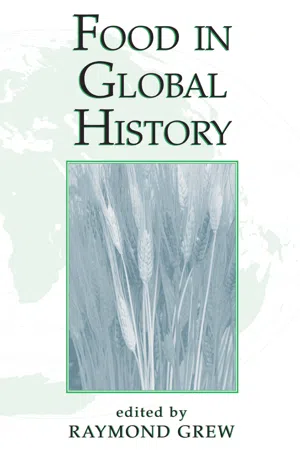Geography
Global Food Consumption
Global food consumption refers to the overall eating habits and patterns of people around the world. It encompasses the types of food consumed, dietary preferences, and the quantity of food consumed by different populations. Factors such as culture, economic development, and agricultural practices influence global food consumption patterns. Understanding global food consumption is crucial for addressing food security, health, and environmental sustainability.
Written by Perlego with AI-assistance
3 Key excerpts on "Global Food Consumption"
Learn about this page
Index pages curate the most relevant extracts from our library of academic textbooks. They’ve been created using an in-house natural language model (NLM), each adding context and meaning to key research topics.
- eBook - ePub
- Bryan L. McDonald(Author)
- 2013(Publication Date)
- Polity(Publisher)
Understanding the relationship between food and security seems more pressing in light of developments in the food system in recent years: recent rises in global food prices and global impacts of localized natural disasters and severe weather events have shown how globally interconnected our food system has become. These developments illustrate the accelerated connections between the world’s places and peoples and highlight the important links between how humans produce, distribute, and consume foodstuffs and pressing social, political, and environmental issues. The ways human populations gain access to food is a defining feature of human civilizations, and today food is a major part of global trade flows and a primary driver of global change processes like land clearance and climate change. While fishing remains an important source of food for many people, the majority of food consumed by humans comes from farming (especially if we take farming in its broadest sense to include the structured production of crops, livestock, and increasingly marine organisms through aquaculture). Agriculture also provides important resources for human societies, from fibers such as wool and cotton to materials such as timber and bamboo. Today’s global food system looks remarkably different from the agricultural and food production systems of previous decades. Despite these distinctions, it is vital to recognize that all these food systems – even the most primitive ones – were shaped by the mingling of human choices and natural systems.This chapter asserts that much of the human relationship to nature has historically been mediated by food, and will also seek to show that today’s food system encounters unique challenges on a massive scale. As such, this chapter begins with an exploration of the concept of globalization as a foundational force in global affairs that is transforming not only security, but also many aspects of social, political and economic life. Next, the chapter moves on to briefly consider the development of human societies from hunters and gatherers to agricultural societies to the modern age. This overview enables us to understand that, first, agriculture and food production systems are networks that humans have shaped to reflect our physical, economic, political, and social needs and desires, and, second, that having enough food to eat (the most basic definition of food security) has long been a central political challenge for human societies. The final section of the chapter considers how one of the most far-reaching and pressing global phenomena – global environmental change – is testing our ability to sustain and manage the global food network and what lessons we might draw from our historical relationships to food and the environment in order to further inform that discussion. - eBook - ePub
- Raymond Grew(Author)
- 2018(Publication Date)
- Routledge(Publisher)
The history of food invites some generalizations about global history more generally The rules of material necessity do apply to the production of food and the need for nutrition. There are limits to the possible. Material conditions, which both inhibit and stimulate change, circumscribe history but do not determine it. As these chapters illustrate, rarely do such constraints explain more than the most basic elements of a society's eating patterns. Foods and cuisines —like technologies, ideas, and fashions —spread beyond the circumstances of their creation to other environments, altering the receiving societies in the process even as they themselves are transformed. Cuisine is never fixed. The meanings of food derive from the way eating intersects with community, and expressions of those meanings matter; for cultures are real, but cultural boundaries are shifting, social creations. Food is a useful marker of difference and cultural purity would be an impoverishment. When the study of food reveals more clearly the interdependence of ecology, property, social structure, international trade, scientific knowledge, public policy, taste, custom, belief, and life style and when that study shows how those interconnections reach around the world, then the history of food has revealed ligatures of global history.Not surprisingly, historical interest in food turns out to have extraordinary relevance to our own times, illuminating issues of development, international cooperation, multinational corporations, public policy, human health, and social identity, while revealing the tensions between tradition and change within specific cultures. These intense contemporary concerns should open up new avenues of historical research that will in turn affect our understanding of the present. Notably, these issues fall within five areas in which global historical scholarship, empirical and theoretical, is particularly strong: the global restructuring of cultures as the result of mass communications, increased leisure, and salient issues of identity; the global networks of production that depend on and locally demand particular structures of land holding, labor relations, and systems of production; the global role of state policies in shaping international connections through empire, international agencies, trade policies, tariffs, and regulations that favor certain interests in the name of public welfare or national need; the global systems of distribution that foster global fashions and patterns of consumption; and the global environmental constraints that become more pressing as technology mines resources around the globe. The chapters in this volume touch on all these areas, indicating both the fruitfulness of current scholarship on global history and the contribution to that history that can come from the study of food. - eBook - ePub
Higher Education and Sustainability
Opportunities and Challenges for Achieving Sustainable Development Goals
- Ulisses Manuel de Miranda Azeiteiro, J. Paulo Davim, Ulisses Manuel de Miranda Azeiteiro, J. Paulo Davim(Authors)
- 2019(Publication Date)
- CRC Press(Publisher)
Taking into account SDG 12: “Ensure sustainable consumption and production patterns” and its relation to SDG 4: “Ensure inclusive and equitable quality education and promote lifelong learning opportunities for all”, the purpose of this chapter is to describe the most important food consumption patterns that contribute to a sustainable diet particularly in developed countries, evaluating the main challenges related to them. The focus on “food system” can be explained by the fact that as contemporary food system’s production is becoming ever more globalized and industrialized, it makes a significant contribution to climate changing GHG emissions, from agricultural production through processing, distribution, retailing and, likewise, food consumption (Garnett 2013). In this context, “food consumption” receives particular attention because consumers make the final choice of the goods and services they consume, and their lifestyles determine how they influence healthy and sustainable practices (Fischer and Garnett 2016). This analysis may contribute to the development of food consumption sciences courses by incorporating the sustainable food consumption perspective in their curricula (Moura and Aires 2018). The necessity of applying online learning is considered, taking into account the fact that e-learning is an important approach to strengthen an inclusive and equitable quality education, becoming widely accepted in formal and non-formal education (Azeiteiro et al. 2015). This task may contribute to the accomplishment of the SDG target 12.8: “By 2030 ensure that people everywhere have the relevant information and awareness for sustainable development and lifestyles in harmony with nature” (UN 2014b).14.2 Food choice determinants: the need for a sustainable diet
As described by Moura and Cunha (2005, p. 206): “food choice is a complex behaviour influenced by many interrelating factors. These factors may be categorized as those related to food, the individual making the choice and the external economic and social environment within which the choice is made (Shepherd 1999). According to Kittler and Sucher (2004), choice of what to eat is typically made according to what is obtainable (food domain), what is acceptable (environmental domain) and what is preferred (individual domain). Moreover, some chemical and physical properties of food are perceived by the individual in terms of sensory attributes (taste, texture, appearance and smell), and the preference towards each of those attributes influences the choice of the food product. Within the limitations of dietary domains, personal preference is most often concerned with the more immediate aspects, such as sensory attributes, convenience, well-being, self-expression, variety or monetary constraints, i.e., the cost of the product against the income (Drewnowski 2002). In sum, individual food choice determinants range in scope from sensory preferences, psychological (mood, stress and guilt) to practical reasons (convenience, price/income, variety) and personal concerns (well-being, self-expression), all being interrelated as consumers are faced with several factors every time decisions about food are made”.


